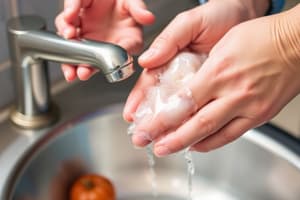Podcast
Questions and Answers
Which of the following actions of food handlers can cause contaminations? (Select all that apply)
Which of the following actions of food handlers can cause contaminations? (Select all that apply)
- Coughing or sneezing (correct)
- Having foodborne illness (correct)
- Washing hands after using the restroom
- Touching ready-to-eat food with bare hands (correct)
What are the five steps to hand washing in order?
What are the five steps to hand washing in order?
Wet hands and arms, apply soap, scrub hands and arms vigorously, rinse hands and arms thoroughly, dry hands and arms.
What is involved in a personal hygiene program?
What is involved in a personal hygiene program?
Hand practices, personal cleanliness, clothing restrictions, hand washing, glove use.
What is the rule regarding fingernail length for food employees?
What is the rule regarding fingernail length for food employees?
Food employees can wear artificial fingernails while working with exposed food.
Food employees can wear artificial fingernails while working with exposed food.
Hand antiseptics can be used instead of washing hands.
Hand antiseptics can be used instead of washing hands.
What are the guidelines for covering cuts and wounds on hands?
What are the guidelines for covering cuts and wounds on hands?
What kind of single-use gloves should be used?
What kind of single-use gloves should be used?
When should you change gloves?
When should you change gloves?
You can touch food with bare hands if it will be cooked.
You can touch food with bare hands if it will be cooked.
What are the rules about hair restraints for food employees?
What are the rules about hair restraints for food employees?
It is acceptable to wipe hands on an apron.
It is acceptable to wipe hands on an apron.
What kind of jewelry can be worn while preparing food?
What kind of jewelry can be worn while preparing food?
When and where can you eat, drink, or smoke?
When and where can you eat, drink, or smoke?
What type of cup can you use in the prep area?
What type of cup can you use in the prep area?
Who should be excluded from a food operation?
Who should be excluded from a food operation?
What are the four ways to prevent cross-contamination?
What are the four ways to prevent cross-contamination?
What is the danger zone temperature range?
What is the danger zone temperature range?
What is the rapid growth danger zone?
What is the rapid growth danger zone?
What are the five ways to avoid time-temperature abuse?
What are the five ways to avoid time-temperature abuse?
Match the type of thermometer with its use:
Match the type of thermometer with its use:
What are the guidelines for using thermometers?
What are the guidelines for using thermometers?
Flashcards are hidden until you start studying
Study Notes
Actions of Food Handlers
- Practices that can lead to food contamination include having a foodborne illness, wounds with pathogens, sneezing, and touching contaminated surfaces without handwashing.
- Symptoms such as vomiting, diarrhea, or jaundice indicate illness and pose contamination risks.
Hand Washing Steps
- Proper handwashing involves wetting hands, applying soap, scrubbing effectively, rinsing thoroughly, and drying hands.
Personal Hygiene Program
- Key components include effective hand practices (washing, care, glove use) and personal cleanliness (appropriate clothing, hair restraints, limited jewelry).
Fingernail Guidelines
- Fingernails must be kept trimmed and cleanable; no fingernail polish or artificial nails allowed when handling exposed food unless gloves are worn.
Artificial Fingernails
- Prohibited in food handling; both artificial nails and nail polish must not be worn.
Hand Antiseptics
- Use hand antiseptics only after thorough handwashing, not as a substitute.
Covering Cuts and Wounds
- Cuts and wounds on hands must be covered with waterproof bandages; gloves or finger cots are required for added protection.
Single-Use Gloves
- Only approved disposable gloves are to be used; never wash or reuse gloves, and provide multiple sizes to accommodate staff.
Correct Use of Gloves
- Always wash hands before wearing gloves, ensure a proper fit, and check for rips or tears once on.
When to Change Gloves
- Replace gloves immediately when dirty, torn, before switching tasks, or after handling raw foods.
Touching Food with Bare Hands
- Allowed only when incorporating food into dishes without raw meat, or if raw meat will be cooked thoroughly.
Hair Restraints
- Employees must wear effective hair restraints to prevent contamination; some roles may have exemptions based on contamination risk.
Apron Rules
- Aprons should be removed when leaving prep areas; do not wipe hands on them.
Jewelry Regulations
- Jewelry should be limited to plain banded rings; avoid necklaces, bracelets, and other items while handling food.
Eating, Drinking, or Smoking
- Permitted only in designated areas, never while preparing, serving food, or in cleaning areas.
Containers in Prep Area
- Use closed containers with lids for drinks in the preparation area.
Exclusion from Food Operations
- Employees exhibiting symptoms like vomiting or diarrhea must be excluded from working.
Restrictions for Employees
- Employees with certain illnesses must be restricted from contact with exposed food and clean equipment.
Preventing Cross-Contamination
- Effective methods include washing hands, surfaces, equipment, and proper food storage.
Danger Zone Temperatures
- Food must be kept out of the danger zone between 41°F and 135°F to prevent bacterial growth.
Rapid Growth Danger Zone
- Temperatures between 70°F and 125°F promote rapid bacterial growth.
Avoiding Time Temperature Abuse
- Monitor temperatures, use effective tools, record data, manage time and temperature, and take corrective actions when needed.
Types of Thermometers
- Immersion probes are for liquids, surface probes for flat cooking equipment, penetration probes for thin foods, air probes for storage units, infrared for surface temperatures, maximum registering for highest temperature measuring, and bimetallic for general food temperature monitoring.
Thermometer Guidelines
- Proper use involves cleaning, sanitizing, calibrating, and ensuring accuracy for reliable temperature readings.
Studying That Suits You
Use AI to generate personalized quizzes and flashcards to suit your learning preferences.




